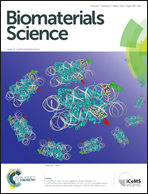A new method to cross-link a polyplex for enhancing in vivo stability and transfection efficiency†
Abstract
Disulfide-exchange was found to cross-link the polyplex of disulfide-containing poly(amido amine) and pDNA with heating of the polyplex solution over a short time. The cross-linked polyplexes based on disulfide-containing poly(amido amine) have excellent stability under physiological salt conditions, and have significantly enhanced transfection activity in the serum media compared to non-cross-linked polyplexes. In vivo, ICR mice were injected with the polyplex through the tail vein, the results show that the transfection efficiency of the cross-linked polyplex is higher than that of the non-cross-linked variety. Furthermore, the polyplex containing Cy5 labelled DNA was also injected into the mice to illustrate the stability and distribution of the polyplex, cross-linked polyplexes show a much brighter luminescence than the non-cross-linked ones. This method does not need a cross-linker or catalyst, and there are no impurities produced, it may be an elegant approach to resolve the dilemma of in vivo application of a DNA polyplex, with excellent stability whilst in circulation and a rapid unpacking of the polyplex inside the cells.


 Please wait while we load your content...
Please wait while we load your content...